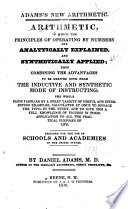 | Charles Guilford Burnham - 1837 - 266 páginas
...thefirst term, the number of terms, and the ratio are given, to find the sum of the series, Involve the ratio to a power whose index is equal to the number of terms, from which subtract 1, divide the remainder by the ratio less 1, and the quotient multiplied by the... | |
 | James Thomson (LL.D.) - 1837 - 296 páginas
...this kind. RULE I. The first terra and the ratio being given, to find any other proposed tern : (1.) Raise the ratio to a power whose index is equal to the number of the terms which precede the required term. (2.) Then, if it be an increasing series, multiply the first... | |
 | Daniel Adams - 1838 - 282 páginas
...first term, the ratio, and the number of terms, are given, to find the sum or amount of the series, — Raise the ratio to a power whose index is equal to the number of terms, from which subtract 1 ; divide the remainder by the ratio, less 1, and the quotient, multiplied by... | |
 | Daniel Adams - 1839 - 268 páginas
...first term, the ratio, and the number of terms, are given, to find the sum or amount of the series, — Raise the ratio to a power whose index is equal to the number of terms, from which subtract 1 ; divide the remainder by the ratio, less 1, and the quotient, multiplied by... | |
 | Frederick Emerson - 1839 - 300 páginas
...performing them. PROBLEM I. The first term and the ratio being given, to find any other proposed term. RULE. Raise the ratio to a power, whose index is equal to the number of terms preceding the required term: then, if it be an increasing series, multiply the first term by this power... | |
 | Daniel Adams - 1840 - 278 páginas
...first term, the ratio, and the number of terms, are given, to find the sum or amount of the series, — Raise the ratio to a power whose index is equal to the number of terms, from which subtract 1 ; divide the remainder by the ratio, less 1, and the quotient, multiplied by... | |
 | Charles Guilford Burnham - 1841 - 324 páginas
...the first term, the number of terms, and the ratio are given, tofind the sum of the series, Involve the ratio to a power whose index is equal to the number of terms, from which subtract 1, divide -the remainder by the ratio less 1, and the quotient, multiplied by the... | |
 | Pliny Earle Chase - 1844 - 246 páginas
...had been given, and the first required, we uhould evidently have been obliged to divide by 3s. RULE. Raise the ratio to a power whose index is equal to the number of terms less one. Then for the last term multiply, and for the first term divide, the given extreme by this power of the ratio.... | |
 | Pliny Earle Chase - 1844 - 258 páginas
...had been given, and the first required, we ahould evidently have been obliged to divide by 3i. RULE. Raise the ratio to a power whose index is equal to the number of terms less one. Then for the last term multiply, and for the first term divide, the given extreme by this power of the ratio.... | |
 | Charles Haynes Haswell - 1844 - 298 páginas
...the First Term, the Ratio, and the Number of Termt are given, to find the Sum of the Series. RULE.— Raise the ratio to a power whose index is equal to the number of terms, from which subtract 1 ; then divide the remuiudcr by the ratio less 1, and multiply the quotient by... | |
| |